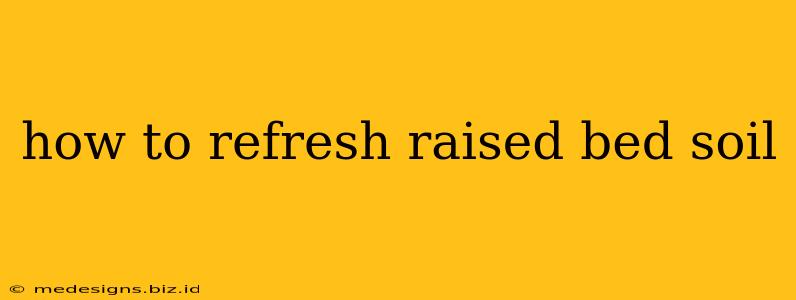Tired of lackluster harvests from your raised beds? Don't let depleted soil hold back your gardening dreams! Refreshing your raised bed soil is crucial for maintaining healthy plants and abundant yields year after year. This guide will walk you through the process, ensuring your raised beds are ready to produce their best.
Why Refresh Your Raised Bed Soil?
Over time, raised bed soil loses its vital nutrients. Plants constantly draw essential elements like nitrogen, phosphorus, and potassium, leaving the soil less fertile. Furthermore, the soil structure can degrade, becoming compacted and less able to retain water and air, crucial for healthy root growth. Refreshing the soil addresses these issues, revitalizing your garden for optimal plant health and increased productivity.
Signs Your Raised Bed Soil Needs Refreshing:
- Poor plant growth: Stunted growth, yellowing leaves, and smaller yields are clear indicators.
- Compacted soil: Soil that's difficult to dig or feels hard and dense.
- Nutrient deficiencies: Visible signs of nutrient deficiencies in your plants, such as leaf discoloration.
- Poor drainage: Water pooling on the surface after watering.
- Pest and disease buildup: Increased incidence of pests and diseases in your raised beds.
Methods for Refreshing Raised Bed Soil
There are several effective ways to refresh your raised bed soil, depending on your needs and the extent of soil degradation.
1. Top Dressing: A Simple Refresh
For a quick and easy refresh, top dressing involves adding a layer of fresh compost or other organic matter to the top of the existing soil. This adds nutrients and improves soil structure without completely removing the old soil.
- How to do it: Remove any weeds or debris from the surface. Spread a 2-4 inch layer of compost, aged manure, or other organic matter evenly over the bed. Gently mix it into the top few inches of existing soil.
2. Partial Soil Replacement: A More Thorough Approach
If your soil is significantly depleted or compacted, partial soil replacement is a better option. This involves removing a portion of the old soil and replacing it with fresh, nutrient-rich soil.
- How to do it: Remove the top 6-12 inches of soil, discarding the old soil. Replace it with a mixture of fresh soil, compost, and other amendments tailored to your plants' needs.
3. Complete Soil Replacement: A Fresh Start
For severely degraded or disease-ridden soil, complete soil replacement is necessary. This involves removing all the old soil and starting fresh with a completely new soil mix.
- How to do it: Empty the raised bed completely. Clean the bed thoroughly to remove any remaining debris or pathogens. Fill the bed with a fresh mixture of soil, compost, and other amendments.
Choosing the Right Soil Amendments
The success of refreshing your raised bed soil relies heavily on using appropriate soil amendments. These materials improve the soil's structure, drainage, and nutrient content.
- Compost: A fantastic source of organic matter, improving soil structure and nutrient content.
- Aged Manure: Adds nutrients and improves soil structure but needs to be well-rotted to avoid burning plants.
- Coco Coir: A sustainable alternative to peat moss, improving water retention and aeration.
- Perlite or Vermiculite: Improve drainage and aeration, particularly in heavy clay soils.
Maintaining Healthy Raised Bed Soil
Regular maintenance is key to preventing soil depletion. Consider these practices:
- Crop rotation: Rotating crops helps prevent the depletion of specific nutrients.
- Cover cropping: Planting cover crops between growing seasons helps improve soil health.
- Mulching: Applying mulch helps retain moisture, suppress weeds, and regulate soil temperature.
- Regular soil testing: Regular soil tests will help identify any nutrient deficiencies.
By following these steps, you can ensure your raised beds remain productive and vibrant for years to come, leading to bountiful harvests and a thriving garden! Remember to choose the method that best suits your soil's condition and your gardening goals. Happy gardening!
